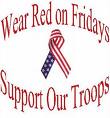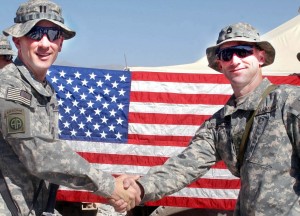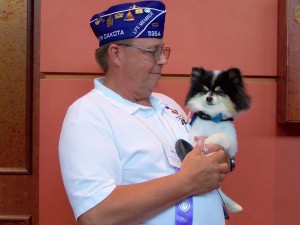Sep
30
Red Fridays
Filed Under American Patriotism, Events, Today's War | Comments Off on Red Fridays

RED FRIDAYS —– You will begin seeing a great many people wearing Red every Friday.
The reason?
Americans who actively support our troops used to be called the ‘silent majority’. We are no longer silent, and are voicing our love for God, country and home in record breaking numbers.
We are not organized, boisterous or over-bearing. We get little media coverage on TV, to reflect our message or our opinions.
Many Americans, like you, me and our friends, simply want to recognize that the vast majority of Americans support our troops.
Our idea of showing solidarity and support for our troops with dignity and respect starts on Friday – and continues each and every Friday until the troops come home from war.
Every red-blooded American who supports our men and women afar should consider wearing something red.
A bunch of us are doing this.
Please join us.

Sep
29
by Janet Seahorn

Have you ever heard a song a hundred times and never thought much about it?
Then one day, you are driving down the road with nothing to obscure your mind; you hear this very same song and it suddenly hits a new note, a new way of thinking about the words, and you wonder why did I never recognize the amazing connection?
Such an incident came to me a week ago while I was steering down the highway. I heard a song from Josh Groban’s album, Awake, called “Weeping”. What took me by surprise was how closely the words seemed to describe the silent torment of trauma.
How experiencing a truly shocking event, the mind, body, and spirit continues to relive the disturbing details as if they were happening in present time.
How, no matter what you try, how much you do to contain or remove the frightening thoughts, they still seem to remain.
The words from the song “Weeping” is another way to describe those living with Post Traumatic Stress. See if you agree – I only wrote down a verse and the poignant chorus.
I knew a man, who lived in fear,
It was huge, it was angry, it was drawing near.
Behind his house a secret place
Was the shadow of a demon he could never face.
He built a wall of steal and flame
And men with guns to keep it tamed…
It doesn’t matter now,
it’s over anyhow,
He tells the world that it’s sleeping.
But as the night came out
I heard a lonely sound
It wasn’t roaring, it was sleeping.
So where are those “secret” places where the demons hide? And, even more important, how many sufferers are strong and courageous enough to face them, deal with them, and move forward?
For there are no walls high enough, no amount of men with guns that will be able to tame one’s internal demons.
In the end, perhaps the residue of trauma isn’t fueled by fear and anger at all; perhaps what remains is fueled by a sense of deep sorrow. A sorrow provoked by dreams of what could have been. Sorrow from what was lost and the silent weeping formed from loneliness and regret.
And perhaps, with enough time, enough support, and enough courage even the weeping will cease and be replaced with hope and joy.
Sep
23
The Teeter Totter Journey
Filed Under Life, PTSD | 2 Comments
 by Janet Seahorn
by Janet Seahorn
Ever think of life as a “teeter totter journey”? Sometimes you’re up, sometimes your down, and when everything is in perfect balance, you are somewhere in-between.
The biggest challenge on a teeter totter is keeping that perfect balance. The certainty of teeter tottering is that equilibrium doesn’t last very long. As soon as the tiniest shift occurs on either side, the mechanism moves.
When you were a child playing on the teeter totter, the fun wasn’t keeping the slab of wood in balance; it was the fast ups and downs as you tried to give your partner a very exciting ride.
Life is a bit like that teeter totter. Some days we are up, some days down, and, every so often, we are within the perfect balance. If we really examined it, however, we would notice that most of our time is spent in the process of moving between the ups and the downs.
This is not good or bad. It just is. Post-Traumatic Stress can be life’s ultimate teeter totter. The ride is faster, quicker, and more unpredictable than the average, and those times of stability may seem shorter. Those individuals on the PTSD cycle are there for good reason; they have experienced life at some of its highest highs, and it very lowest lows. The speed of change, therefore, tends to be faster, more unpredictable. At times it can make one queasy from experience.
Playing on a teeter totter requires at least two people; you can’t get up without someone on the other end helping you there. It’s a push, pull, and bumps boogie.
Those living with Post-Traumatic Stress and family members who become part of the journey often experience the same unpredictable, sudden change in highs and lows. Yet, perhaps, the most important message in this blog is simply this: if either rider decides to abandon the wooden slab, the remaining rider can be at peril, depending on where they sit.
And herein lies both the gift and the tragedy. Those of us who live with the after effects of combat trauma (or any trauma causation) make a choice every single day to continue the journey together.
Yep, life is a teeter totter journey.
Sep
16
The Strength of One
Filed Under Civilian life, PTSD treatment | 6 Comments
-by Janet Seahorn

It had been several months since I last saw him. The end of last semester during finals to be exact. He had been a student in one of my university classes. He was a big, strapping, young man who almost always had a smile on his face and some funny comments to amuse his table mates.
Before that semester began, I knew that several of my new students were National Guard or had served in the military; he was among them. On one occasion, he told me that he had been on active duty and had just returned from a tour in a war zone. Iraq one day, and the next day he was signed up and attending classes at the university. No transition time whatsoever. Yet, he seemed to take it all in stride. He even joined a fraternity.
A few times I had spoken with him about some of his experiences and asked if he knew anything about Post Traumatic Stress. Without much dialogue he nodded and mentioned that he had some symptoms but he was coping quite well. And by all outward appearance and on most days he was fine. Only a few times did I recognize the demons had visited him, but thankfully, they didn’t seem to stay very long.
The semester wore on without much concern until the last month when he was absent a few times – until then he attended every class and only missed on rare occasions. One absence occurred the first day of class. He had e-mailed me ahead of time to let me know he would be missing that session because he was attending the funeral of one of his best friends. Only later did I learn the funeral was a young marine who had been in our local papers and had recently died in Iraq.
The marine had been a close high school friend. They had been star players on their football team, shared Saturday night outings built on a foundation of boyhood friendship.
After our “catch-up” talk, he mentioned that the summer had been tough. He had an accident which broke some bones in his ankle. He could not participate in all of the fun activities that had anticipated during the school year. Given the pain and the down time of recuperation, the memories resurfaced; the trauma of his tour of duty in Iraq, what he saw and had to cope with, the decisions he had to make on a daily basis – returned to haunt him.
Typical of his strong personality, he downplayed most of the symptoms. Yet, this is an intelligent young man. He did not dismiss the symptoms and stated that he was getting help for his PTSD. Just knowing this put my mind at ease. I could only imagine what courage it took to take this step. Hopefully, other vets who know him will follow his example. He will get better – faster, in a healthier manner.
Just a side note: I no longer choose to call this a “disorder”. It seems to me the more I learn and understand this phenomenon, the more I believe that PTS(D) is the minds/body’s incredibly creative way to deal with an unusually horrendous life event.
Had the mind not employed the immediate reaction of numbing and stuffing the event, the person may have died. To avoid the ultimate death sentence, the mind/brain made a split second decision to unconsciously remove itself from the trauma until a later time; a time when the body was safe to explore the event without being in the line of fire.
Pretty amazing and effective when you think about it. If the brain wasn’t such a protective, innovative problem solver many of us would not be around today. Yea, for our amazing brain. Maybe it is not “disordered” at all, just creatively restructured for a bit.
In a few weeks I will attend a conference on Traumatic Brain Injury (TBIs). Of course I will be writing about this experience and sharing some of the information with our blog readers. Stay tuned.
Sep
8
A New Beginning
Filed Under PTSD treatment, Treating PTSD | 1 Comment
-by Janet Seahorn

In a previous blog we wrote about the Wilderness and Healing. Before that we talked about how PTSD + Joy = Peace, Maybe — can move us toward wellbeing.
This week’s focus is a continuation of both ideas, an extension of how we can heal, can move forward and grow healthier. What every suffering person is searching for is a GENISUS – a new beginning, new start, a sort of rebirth.
So this is the big question, “what will be our new beginning after a trauma experience?” Trauma does not have to be the end of living, but a start of living life in a new way. It begins with the seeds we are now and grows into the people we want to become.
Imagine that person, vision it with all the bright pictures, melodies, and glory we can see, hear, and feel in our hearts. New beginnings ask us to examine what we learned from our combat/trauma experience, to go beyond the pain and terrible memories, and to rise above them.
To accomplish this mission will require that we put ourselves fully into the human arena. Isolation is not an option. We cannot lock ourselves away physically or emotionally; that means drugs, alcohol, over-working… are simply not possible choices.
The world is too rich, too interesting, too special to isolate ourselves. Yes, there are horrible things that occur. There is violence, greed, and cruel acts. And for every act of brutality, I believe there are many more acts of kindness, beauty, and love. We must not forget to notice these during our times of darkness. We must attempt to appreciate the goodness in the world. It is present. Just look.
An old saying states, “What we focus on persists”. What do we want to persist? We can focus on those things. Write them up. Put them on our refrigerators, nightstands, even our mirrors. The new us begins today. We choose. By no means will it be easy. The new us will not be perfect, but it will be real.
Like the Velveteen Rabbit, he became worn, torn, and aged only through the experience of being touched, loved, and used. And by going through all of his living, he became real. He developed into being alive, for being alive required a multitude of life events both magnificent and sad.
I am sure that if one were to inspect the experiences of the rabbit, he may have been diagnosed with PTSD. And, I am equally sure, that at the end of his days, he would not have traded these experiences for something easier and less physically or emotionally demanding.
He chose life, and so will we!
Sep
1
Never Apart
Filed Under Dogs, Pets, PTSD treatment, Purple Heart | 1 Comment
by Janet & Tony Seahorn
 It was a small, black & white, furry 5-pound bundle of emotional and physical relief. His name was Petie, the keeper of an adult warrior, Purple Heart, Vietnam Veteran.
It was a small, black & white, furry 5-pound bundle of emotional and physical relief. His name was Petie, the keeper of an adult warrior, Purple Heart, Vietnam Veteran.
The vet trained him as his first alert. An important task. Petie knew when his master needed to take his medications. He would wakeup Dennis at various times in the middle of the night so that specific pills were administered at the most critical time in order to keep the Post Traumatic Stress under control.
Dennis trained Petie especially for this purpose. They are best friends and constant companions, never apart. This small, furry medic is essential, not just for the vet’s physical well-being, but even more important, his emotional/mental stability.
Petie alerts Dennis when there is danger in the surroundings. He watches intently everything that goes on with his owner and around his owner. If Petie isn’t comfortable his master knows to pay closer attention to his current environment. If Petie doesn’t like you, more than likely Dennis isn’t going to become too friendly either.
They coexist, two different species, one functioning entity.
There are numerous organizations that train service dogs. Dogs that serve the deaf, blind, and epileptic individual. Dogs that act as the arms and legs of those who no longer have capacity to move on their own. Now, some of these groups are training dogs to do something even more challenging, knowing when their owner may go into a PTSD anxiety attack.
The dog must sense when such attacks may occur before they actually manifest themselves. They know even before the person that something is coming on – giving their owner an opportunity to breathe, use relaxation techniques, and take medication if necessary. They provide a sense of security and well-being in a world filled with unpredictability and potential stressors.
One such training organization is NEADS – Dogs for Deaf and Disabled Americans.
They are conducting an in-depth study of nine-ten Iraq vets who has severe PTSD. The study’s focus is to evaluate the most effective canine training methods that serve the sensitive needs of a veteran suffering from combat stress.
This is a very expensive and challenging research project because it must take into account the behaviors of two very different organisms: human and canine.
It will be a critical piece of information given the increasing number of individuals returning from the Iraq and Afghanistan theaters and those that have served in past wars such as Vietnam and the Gulf War.

